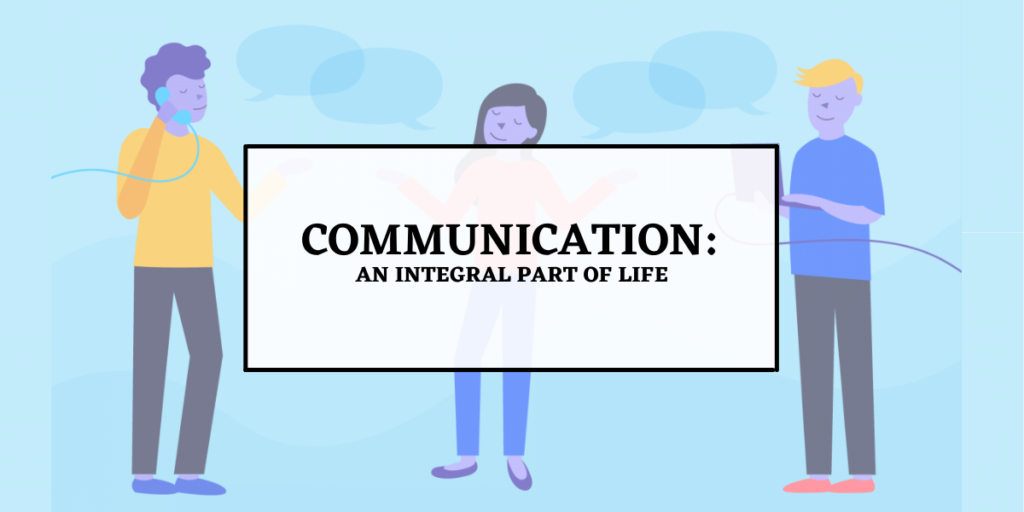What is communication?
Communication is a process through which people interact and exchange information with others.
It is basically the creation and exchange of meaning consisting of a series of actions that varies on method, channel, and person.
Process of communication
It is a continuous process that mainly involves three elements namely sender, message, and receiver. The process is explained below :
SENDER :
The sender is the one who starts the communication by generating a message and conveying it to the receiver.
MESSAGE:
It is the information, idea, opinion, facts, etc. that the sender wants to convey to the receiver.
ENCODING:
The message generated by the sender is encoded in the form of words, gestures, pictures, or any other symbols before being conveyed to the receiver.
MEDIA:
It is the path through which the encoded message is transmitted to the receiver. The sender has to decide the mode of medium for example telephone, internet, post, fax, e-mail, etc.
DECODING:
It is the process of converting the symbols encoded by the sender then receiving the message from the receiver.
RECEIVER:
The receiver is the one to whom the message is supposed to reach. The process of communication is completed only when the receiver receives the message, understands the message, and then acts on it.
FEEDBACK:
Once the receiver confirms to the sender that he has received and understood the message, the communication process is complete.
The Four Communication Styles
- Passive Communication
It is a style in which people develop a pattern of not expressing their opinions, feelings, protecting their rights, and identifying & meeting their needs. These people do not respond to hurtful, complicated or situations including anger. They store grievances and usually burst them out when they have reached high tolerance. They feel guilty, ashamed, bad after the outburst and get back to being passive.
- Aggressive Communication
It is a style in which individuals express their opinions or feelings in a way that violates the rights of others. Aggressive communicators are verbally or physically abusive. They try to dominate, criticize, blame, humiliate others, they have low tolerance, they’re very impulsive.
- Passive-Aggressive Communication
The passive-aggressive style displays a mixture of both. This type of communicator might seem passive, but they probably harbor an aggressive side underneath. Behaviorally, they might seem agitated and display facial expressions or nonverbal cues that don’t match what they’re saying. These people often mutter to themselves rather than confront the issue or person and also have difficulty acknowledging their anger.
- Assertive Communication
It is a style in which the communicators clearly state their opinions and feelings without violating the rights of others. These individuals value themselves. their time, and their emotional, spiritual, and physical needs and are strong advocates for themselves while being very respectful of the rights of others. They are generally calm and listen well without interrupting, they feel connected to others and are always in a feeling of self-control.
Types of Communication
- Verbal Communication:
It includes communicating through words, sentences, sounds, and language. This is the most effective way to express emotions, ideas, opinions, and needs. Correctly used verbal communication helps to solve any purpose easily leaving less space for assumptions and questions.
There are four types of verbal communication namely intrapersonal, interpersonal, small group, and public.
- Non-Verbal Communication:
It includes non-verbal means of communicating such as body language, gestures, inflection, facial responses, etc.
It also includes creative means of communication such as painting, pottery, etc. Some of its examples are eye contact, shaking hands, hugging, moving eyebrows.
- Written Communication:
It includes communicating through written words or text. Unlike verbal or non-verbal and written communication can be edited before the message is sent. Some of its examples are memos, letters, blog posts, reports, etc.
- Visual Communication:
It includes sending and receiving messages with the help of visual aids. Movies, tv shows, and plays are some examples as receivers need to watch them get the message. Even emojis are a form of visual type.
Effective Communication Skills
Effective Communication isn’t just speaking clearly. It also involves creating a comfortable environment for the exchange of ideas even if you are not the sender. Here are some basic skills that help to send and receive messages effectively.
- Listening Actively
Active listening refers to focusing and understanding the emotions of the sender instead of just hearing the message.
It includes simple steps like:
– Focusing on the other person
– Showing interest
– Asking questions
– Avoiding pre-judgment
- Asserting yourself :
It means considering our opinions, thoughts, feelings and communicating them in a clear and respectful manner.
Asserting yourself can help you stick to your goals while communicating. Although effective communication is more about understanding the other person it’s important to not forget your own motive.
- Minimizing Stress :
It’s important to be comfortable and reduce stress in order to communicate effectively. One should stall to collect thoughts, make one point at a time, avoid interruption and try to stay on the objective.
Barriers to Effective Communication
These are the following barriers that may be hindering your communication :
- Linguistic/Cultural Barriers
Linguistic or cultural barriers come in between when two people speak different languages or understand different meanings of the same language. Their ways of communicating are different culturally like accent, body language, etc.
For example, in MNCs, the workplace environment is really diverse as it consists of employees from different parts of the world and it may happen that they all understand different meanings of one single phrase.
- Psychological/Attitudinal Barriers
Psychological or attitudinal barriers occur when one or both parties involved in the communication process carry cultural assumptions with them or are restricted by any past experiences. For example, an employee joining a new company will assume that the new company has the same rules as the old one, which will further restrict his communication.
- Physical Barriers
Physical barriers are anything that physically comes in the way of clear communication like texts, emails, etc. which basically don’t face to face.
For example, employees receiving results of their tasks via email may get disheartened and misunderstand the tone of their boss while he is happy with their performances.
Conclusion
Communication plays a vital role in human life. It helps to facilitate the exchange of information and knowledge, and develop relationships with others. Therefore, the importance of communication skills in our day-to-day life cannot be underestimated.
Do check out our other blogs.
- PROCRASTINATION: A THIEF OF YOUR TIME?
- WORKPLACE STRESS- POSITIVE OR NEGATIVE?
- Self-Motivation
- SUBCONSCIOUS MIND: The Real Controller?

